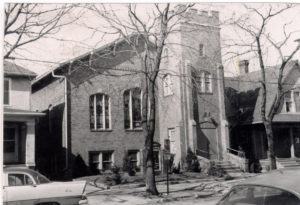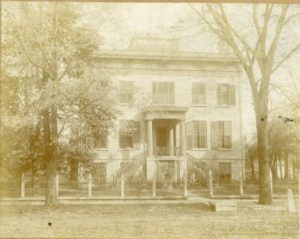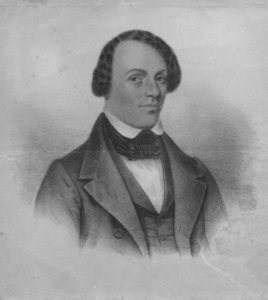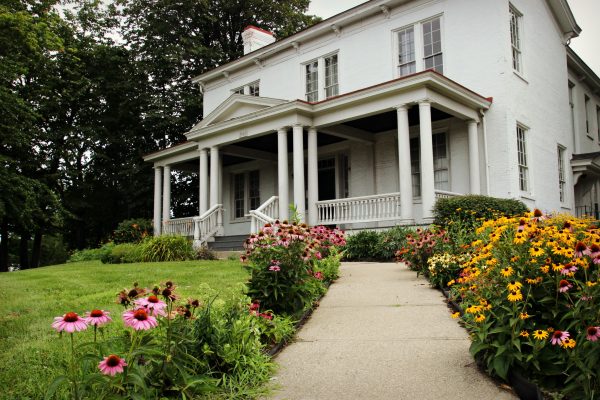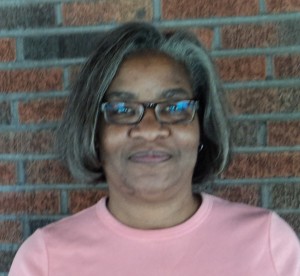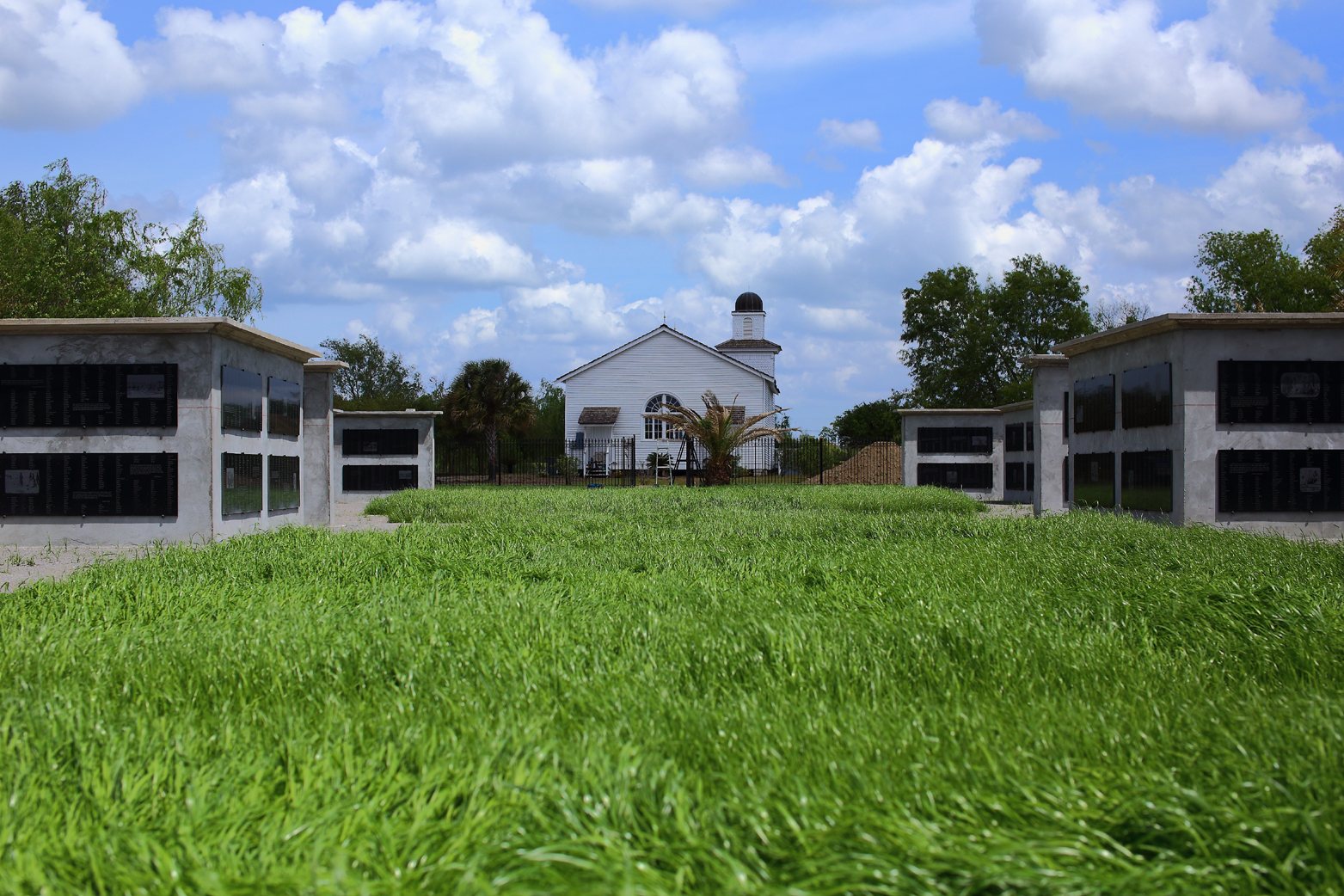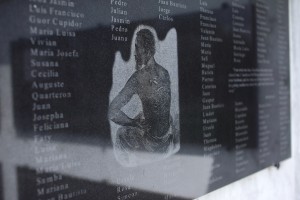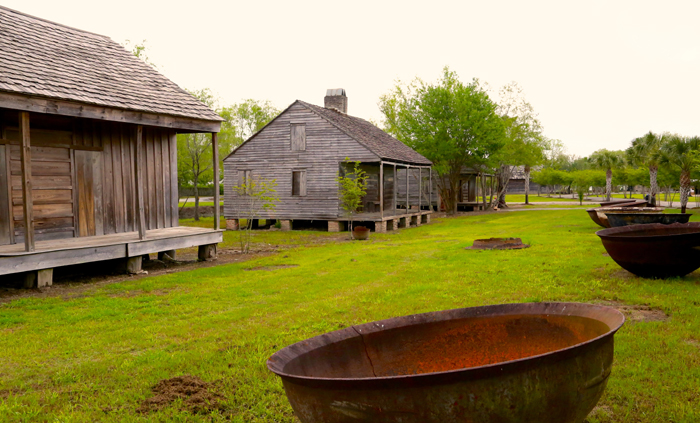by Ron Gorman, Oberlin Heritage Center volunteer docent, researcher and trustee
Frances (“Fanny”) Jackson came to Oberlin in 1860 with a dream – a dream “to get an education and to teach my people”, she said. “This idea was deep in my soul. Where it came from I cannot tell, for I had never had any exhortations, nor any lectures which influenced me to take this course. It must have been born in me.” It was a big dream for a 23 year old woman who ten years earlier had been bought out of slavery by her aunt. But it was a dream that had been nurtured at the Rhode Island State Normal School, would blossom at Oberlin, and would inspire the dreams of thousands of others. [1]
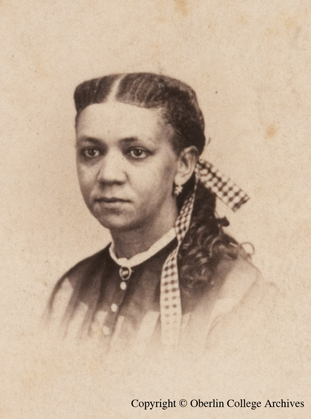
Fanny M. Jackson
(courtesy Oberlin College Archives)
Fanny Jackson entered the Oberlin College preparatory school in 1860, where after a year of study she would make a bold decision. She would enroll in the baccalaureate program (the “gentleman’s course”) at Oberlin College, rather than the literary program commonly prescribed for women. “The faculty did not forbid a woman to take the gentleman’s course,” she explained, “but they did not advise it. There was plenty of Latin and Greek in it, and as much mathematics as one could shoulder.” But with an unquenchable dedication that would characterize her life, she “took a long breath and prepared for a delightful contest.” [2]
At that time no African American woman had ever graduated from Oberlin’s baccalaureate program. But Jackson felt comfortable in Oberlin, even though she felt she “had the honor of the whole African race upon my shoulders.” She would room with the families of Professors Henry Peck and Charles Churchill, and would always acknowledge “the influence upon my life in these two Christian homes, where I was regarded as an honored member of the family circle.” [3]
Jackson’s teaching career began during the extended Oberlin College winter breaks, when she taught a night school, as described by the Lorain County News in 1864:
This School is open to all the Colored people of Oberlin, both young and old, who desire to receive instruction in the elementary branches, reading, writing, spelling, grammar, etc., and is most ably conducted by Miss F.M. Jackson, a young lady of rare accomplishments and devotion to the work. On the evening of our call the exercises were most interesting. The pupils were mostly adults, who, after a hard day’s labor[,] embracing the opportunity afforded them for self-improvement, bent their minds to the task before them with an earnestness and concentration that were truly gratifying. Miss Jackson has the knack of at once interesting and instructing, a fact evidently well appreciated by her scholars who appeared to enter with great enthusiasm into all her novel plans for their improvement. [4]
Jackson found her work with adults who had been kept in ignorance by slavery and prejudice to be immensely rewarding. “It was deeply touching to me to see old men painfully following the simple words of spelling; so intensely eager to learn”, she explained years later. “I felt that for such people to have been kept in the darkness of ignorance was an unpardonable sin, and rejoiced that even then I could enter measurably upon the course in life which I had long ago chosen.” [5]
For practically all of Jackson’s tenure at Oberlin, the United States was embroiled in Civil War. Jackson watched closely as her white classmates enlisted in droves to fight for the Union cause and her black classmates were turned away – admonished that “this is a white man’s government… white men are able to defend and protect it.” When the federal government finally did allow black men to serve in 1863, the state of Massachusetts raised the first black northern regiment: the 54th Massachusetts Volunteer Infantry. Jackson, voted “class poet” by her college classmates, wrote a poem in honor of the men who enlisted in this regiment, which included eighteen Oberlinites. It was published on page one of the Lorain County News and minced no words as to what the men of the 54th were fighting for: [6]
Now, Freedom stands holding with uplifted face,
Her hands, dipped in blood, on the brow of our race.
Attest it! my country, and never again
By this holy baptism, forget we are men,
Nor care, when we’ve mingled our blood in your battles,
To sneer at our manhood and call us your “chattles.” [7]
But in this same year of the Emancipation Proclamation and bloody draft riots, Jackson noted that “a very bitter feeling was exhibited against the colored people of the country, because they were held responsible for the fratricidal war then going on.” It was in this volatile environment that the faculty of Oberlin College embarked on a bold endeavor. “It was a custom in Oberlin that forty students from the junior and senior classes were employed to teach the preparatory classes,” Jackson explained. “As it was now time for the juniors to begin their work, the Faculty informed me that it was their purpose to give me a class, but I was to distinctly understand that if the pupils rebelled against my teaching, they did not intend to force it.” [8]
Unlike the voluntary classes she had taught so far, Jackson would be teaching a compulsory class of mostly white students – the first African American teacher to do so. Certainly the faculty’s hedge against forcing the issue would be considered unacceptable and discriminatory by today’s standards, but in 1863 America, where the Supreme Court of the land had a standing ruling that descendants of Africans were “so far inferior that they had no rights which the white man was bound to respect”, Jackson understood that “it took a little moral courage on the part of the faculty to put me in my place against the old custom of giving classes only to white students.” What she didn’t mention was that it took even greater courage for herself to accept the offer. But where the cause of education or the advancement of her race or gender was at stake, Jackson would never back away from the challenge. The result was, in her own words, “an overwhelming success”: [9]
Fortunately for my training at the [Rhode Island] normal school, and my own dear love of teaching, tho there was a little surprise on the faces of some when they came into the class, and saw the teacher, there were no signs of rebellion. The class went on increasing in numbers until it had to be divided, and I was given both divisions. One of the divisions ran up again, but the Faculty decided that I had as much as I could do… [10]
The Principal of the Preparatory Department was “delighted” with the results. A visiting reporter from an African American Philadelphia newspaper described it even more glowingly: [11]
It affords us much pleasure to say, that we never saw a teacher who took so much pains to explain every thing so clearly, as did Miss Fanny, to her class. Her manners are very pleasant and graceful. Her class is very large, being composed of both white and colored. She is the first colored person that ever taught in this institution, and we are proud of her. In the class she now teaches, the young white men and girls were a little prejudiced against her, when she was first placed as a teacher over them by the Faculty, but now they deem it an honor to be taught by her. [12]
Indeed, one student was so upset after his first class that “he came into his boarding place, flaming with indignation, and threatening to write at once to his parents and get taken home again, because his teacher was a woman, and a BLACK woman. But his matron persuaded him to a little delay, and it was not long before he preferred Miss Jackson to any other teacher.” [13]
In 1865, Fanny Jackson graduated from Oberlin College with a bachelor’s degree. Interestingly, she was not now the first black woman to do so. Mary Jane Patterson had attained that honor at Oberlin in 1862 (and perhaps was the first black woman in the country to earn that degree). Both women would now be offered teaching positions at the Institute for Colored Youth in Pennsylvania, but ironically Jackson would be appointed Principal of the Female Department, while Patterson would become her assistant. [14]
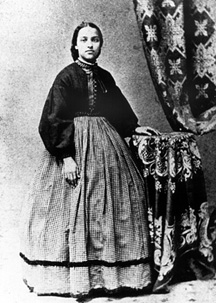
Mary Jane Patterson
(courtesy Oberlin College Archives)
Jackson was thrilled about the Institute and her prospects, writing:
In the year 1837, the Friends [Quakers] of Philadelphia had established a school for the education of colored youth in higher learning. To make a test whether or not the Negro was capable of acquiring any considerable degree of education. For it was one of the strongest arguments in the defense of slavery, that the Negro was an inferior creation formed by the Almighty for just the work he was doing. It is said that John C. Calhoun made the remark, that if there could be found a Negro that could conjugate a Greek verb, he would give up all his preconceived ideas of the inferiority of the Negro. Well, let’s try him, and see, said the fair-minded Quaker people. And for years this institution, known as the Institute for Colored Youth, was visited by interested persons from different parts of the United States and Europe. Here I was given the delightful task of teaching my own people, and how delighted I was to see them mastering Caesar, Virgil, Cicero, Horace and Xenophon’s Anabasis. We also taught New Testament Greek. [15]
Already after her first week of teaching, the Quaker managers of the Institute declared her a “very valuable acquisition” and noticed a “greater animation of manner and a louder and clearer mode of speaking among the girls.” In her first year, enrollment in the Female Department almost doubled. She lived and taught by a simple philosophy: “Many a child called dull, would advance rapidly under a patient, wise and skillful teacher, and the teacher should be as conscientious in the endeavor to improve himself as he is to improve the child.” [16]
By 1869 the managers were so impressed that they promoted her to head Principal of the entire Institute, the first African American woman in the country to take such a position. At that time, Mary Jane Patterson resigned and took a teaching position in Washington, D.C. Two years later she too would become a Principal, of the Preparatory High School for Colored Youth (the forerunner of prestigious Dunbar High School).
The focus of the Institute for Colored Youth in Philadelphia at this time was to train students to become teachers themselves, a task that was not only sacred to Jackson, but was critical in this era of Reconstruction, when millions of freedmen needed and yearned for education. Indeed during the interval from 1861 to 1875, the Institute would send 56 known teachers to the South, comparing favorably with the 290 known teachers sent from the much larger Oberlin College, which sent far more than any other northern academic institution. [17]
But Jackson realized that not all students were meant to be teachers, and so as the Reconstruction era came to a close in the late 1870s, she embarked upon what she called an “Industrial Crusade”, to bring industrial education to the Institute: [18]
At a meeting of the public school directors and heads of some of the educational institutions, I was asked to tell what was being done in Philadelphia for the industrial education of the colored youth. It may well be understood I had a tale to tell. And I told them the only place in the city where a colored boy could learn a trade was the House of Refuge or the Penitentiary, and the sooner he became incorrigible and got into the Refuge or committed a crime and got into the Penitentiary, the more promising it would be for his industrial training. It was to me a serious occasion. I so expressed myself. [19]
Despite the tremendous regard the managers of the Institute held for their Principal, they were reluctant to move in this direction. But Jackson would not be deterred. It would take a decade of diplomatic persuasion, but ultimately the industrial school would become a reality. By this time Fanny Jackson had become Mrs. Fanny Coppin, marrying the Reverend Levi Coppin of Baltimore’s African Methodist Episcopal Church, who had been impressed by her “irreproachable character” and her “undisputed leadership in all matters of race advancement.” [20]
In 1890 a large celebration was held to honor Mrs. Coppin’s 25th anniversary with the Institute. By then thousands of students had studied under her tutelage, 3/4ths of the black teachers in Philadelphia and nearby Camden were graduates of her Institute, and there was a waiting list to get in. In addition to her schoolwork, she founded the Women’s Exchange and Girls’ Home for disadvantaged females in Philadelphia, and wrote a women’s column for an influential African American Philadelphia newspaper. [21]
Through the 1890s, the industrial college turned out to be an unqualified success, training bricklayers, shoemakers, carpenters, printers, plasterers, tailors, dressmakers, and stenographers. Mrs. Coppin insisted that women be included in the courses as well as men. “During my entire life, I have suffered from two disadvantages,” she told one audience, “first, that I am a woman; second, than I am a Negro.” But as the 19th century drew to a close and the 20th century was ushered in, changes were in the air. Mrs. Coppin began to have health problems. Reverend Coppin was appointed a Bishop in South Africa. And the managers of the Institute requested that Mrs. Coppin “tone down” her beloved academic curriculum, claiming that it was “pitched too high”, and began a move towards a re-organization that stressed more elementary courses and “manual training” in its stead. [22]
These factors, to varying and unknown degrees, likely influenced Mrs. Coppin’s decision in 1902 to resign from the Institute after 37 years of service. But she left on good terms. The newly appointed “Committee to Re-organize the Institute” reported: “Your committee has much satisfaction in recording the high esteem that they have found general for the past work of the Institute and the enlightened views of its devoted head, Frances J. Coppin. Radical changes in the future will not of course discredit the work of the past…” [23]
That same year the Coppins moved to South Africa. Mrs. Coppin called it “a fortunate incident to finish my active work right in Africa.” But failing health brought her back to Philadelphia a year later, and there she continued to decline. In her final year of life, at age 75, she wrote her autobiography at the request of her friends. Published shortly after her death in 1913, the book was characteristically only one third about herself, and the remainder about teaching methods and biographical sketches of her colleagues and students. Even the portion that was about herself was full of praise for others. “My obligation to the dear people of Oberlin can never be measured in words,” she wrote. [24]
But that obligation was paid forward – many thousands of times.
SOURCES CONSULTED:
Fanny Jackson-Coppin, Reminiscences of School Life, and Hints on Teaching
Linda Marie Perkins, Fanny Jackson Coppin and the Institute for Colored Youth (PhD dissertation)
Levi Jenkins Coppin, Unwritten History
“Oberlin Colored School”, Lorain County News, Feb 10, 1864, p. 2
“Sketches by the Wayside”, The Christian Recorder, August 26, 1865, p. 2
“To the 54th Mass. Volunteers”, Lorain County News, June 10, 1863, p. 1
“A Worthy Enterprise”, Lorain County News, February 4, 1863, p. 3
“A Fortnight in Oberlin”, National Anti-Slavery Standard, March 11, 1865, p. 3
“Fannie Jackson Coppin, Class of 1865“, Oberlin College
Ronald E. Butchart, “Mission Matters: Mount Holyoke, Oberlin, and the Schooling of Southern Blacks, 1861-1917”, History of Education Quarterly, Spring 2002
William E. Bigglestone, They Stopped in Oberlin
John Mercer Langston, From the Virginia Plantation to the National Capitol
“Scott v. Sandford“, Legal Information Institute
“Fanny Jackson Coppin” graduate file, Oberlin College Archives, RG 28/2, Box 208
Robert Samuel Fletcher, A History of Oberlin College From its Foundation through the Civil War
“Mary Jane Patterson (1840-1894)”, Notable Black American Women
“The Grandeur of our Triumph”, Lorain County News, Nov 15, 1865, p. 1
“From Slavery Onward”, Oberlin Weekly News, Aug 22, 1889, p. 3
“Prejudice at Oberlin”, National Anti-Slavery Standard, July 9, 1864, p. 2
“Notes by the Way”, The Christian Recorder, Nov 27, 1902, p. 1
“Gala Week in Philadelphia”, New York Age, July 5, 1890
“Philadelphia Anniversary”, New York Age, Oct 4, 1890
Ellen N. Lawson and Marlene Merrill, “The Antebellum ‘Talented Thousandth’: Black College Students at Oberlin Before the Civil War,” The Journal of Negro Education, Spring 1983, pp. 390-402
James H. Fairchild, Oberlin: The Colony and the College, 1833-1883
Roland M. Baumann, Constructing Black Education at Oberlin College
“About CU“, Cheyney University of Pennsylvania
“Minority Student Records“, Oberlin College Archives, RG 5/4/3
FOOTNOTES:
[1] Jackson-Coppin, p. 17
[2] Jackson-Coppin, p. 12
[3] Jackson-Coppin, pp. 13-14, 15
[4] “Oberlin Colored School”; “A Worthy Enterprise”
[5] Jackson-Coppin, p. 18
[6] Langston, p. 206; Jackson-Coppin, p. 15; Bigglestone, p. 237
[7] “To the 54th”
[8] Jackson-Coppin, pp. 12, 18
[9] “Fannie”; “Scott”; Jackson-Coppin, pp. 18-19
[10] Jackson-Coppin, p. 12
[11] Jackson-Coppin, p. 19
[12] “Sketches”
[13] “A Fortnight”
[14] “Mary Jane”, pp. 826-827
[15] Jackson-Coppin, pp. 19-20
[16] Perkins, p. 84; Jackson-Coppin, p. 53
[17] Butchart, pp. 7-8
[18] Jackson-Coppin, pp. 27, 36
[19] Jackson-Coppin, p. 28
[20] Coppin, p. 353
[21] Perkins, pp. 160-161, 245
[22] Perkins, pp. 251, 257, 262, 281, 294
[23] Perkins, p. 285
[24] Jackson-Coppin, pp. 13, 122, Preface





